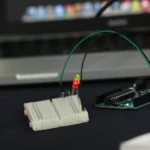
Introduction
The advent of new temperature sensors incorporating advanced integrated circuits (ICs) is revolutionising the design landscape for electronic circuits. These innovative sensors combine the accuracy and sensitivity required for precise temperature measurements with the convenience of compact, all-in-one packages. By integrating the sensor element with the necessary signal conditioning and processing circuitry on a single chip, these IC temperature sensors offer engineers and designers a simplified approach to temperature monitoring and control. This article comprehensively highlights the unique and unprecedented features and benefits of new temperature sensors with ICs, focusing on how they simplify circuit design.
The Significance of Advanced Temperature Sensors with ICs
Though the traditional temperature sensors have served us well, as technology advances, demands for more accurate, reliable, and versatile sensors increase. The new temperature sensors with ICs address these demands by integrating powerful functionalities into a single package, streamlining the design process. Bespoke IC temperature sensors are of significant importance as they provide a plethora of benefits, including minimal power consumption, reliability, durability, reduced costs, and much more, with remarkable features.
Exploring Benefits and Features of New Temperature Sensor ICs Simplifying Circuit Design
The latest temperature sensors with ICs offer unparalleled benefits that come equipped with unique features. Some of the crucial benefits and features include:
- High Accuracy and Stability
The integrated ICs in these sensors provide high accuracy and robust stability, even in challenging environments, ensuring reliable temperature data for critical applications. The precise accuracy with stability makes these sensors ideal for scenarios requiring precise control.
- Compact and Space-Saving Design
With integrated circuitry and small footprints, these temperature sensors drastically reduce the space required on the PCB. This not only simplifies the circuit design but also allows for more compact and sleek device designs in space-constrained applications.
- Integration of Signal Conditioning
One of the key advantages of temperature sensors with ICs is the integration of signal conditioning circuitry within the sensor package. This integration eliminates requiring external components like op-amps or amplifiers, simplifying the design and reducing the overall circuit’s footprint.
- Digital Output and Communication Protocols
Unlike conventional sensors providing analogue output, the new temperature sensors come with digital output and support popular communication protocols such as I2C, SPI, and UART. This digital output offers various benefits, including noise immunity, longer transmission distances, and ease of interfacing with microcontrollers. Additionally, digital production also makes integrating the sensor into complex systems more accessible.
- On-Chip Calibration and Compensation
Calibrating and compensating temperature sensors for accuracy can be a challenging task. With on-chip calibration and compensation capabilities, the new temperature sensors alleviate this burden and are pre-calibrated at the factory. These features ensure high accuracy and reduce extensive calibration approaches in the design phase.
- Reduced Cost and Low Power Consumption
Temperature sensors with ICs offer cost-effectiveness in the long run yet are packed with advanced features, ensuring improved energy efficiency. The new temperature sensors consume minimal power and are ideal for battery-operated devices and energy-efficient applications. The reduced power consumption feature also reduces the circuit’s overall power budget contributing to extending the device’s battery life.
- Fault Detection with Built-In Diagnostics
The IC temperature sensors come equipped with built-in diagnostic features to detect faults and anomalies. The sensors can alert the system to potential issues, enabling proactive maintenance and reducing downtime, ensuring the system’s reliability in the long run.
- Broad Temperature Range Options
Different applications require temperature sensors–operating within specific temperature ranges. The new sensors offer multiple temperature range options, from ultra-low to high temperatures, meeting numerous applications’ requirements without compromising accuracy or performance.
- Robust Durability
The latest sensor ICs can withstand harsh environmental conditions due to their robustness and durable materials. This high durability makes them suitable for applications in extreme temperatures, humidity, or corrosive environments.
- Rapid Prototyping and Time-to-Market
With a simple circuit design and easy integration, these new temperature sensors enable faster prototyping and shorter time-to-market for today’s fast-paced and competitive industries, especially electronics.
Final Thoughts
The emergence of advanced temperature sensors with ICs has significantly improved the world of electronics. These sensors have simplified the circuit design and enhanced temperature sensing technology with their advanced features. Due to the unparalleled benefits, these innovations have ensured improved efficiency with reduced component count and budget, enabling engineers and designers to optimise their applications in various settings.





















